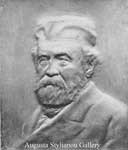Victor David Brenner (original) (raw)

Augusta Stylianou Gallery
<-----===========------->
Loading
Artist Index
A - B - C - D - E - F - G - H - I - J - K - L - M
N - O - P - Q - R - S - T - U - V - W - X - Y - Z
Sculptures

Victor David Brenner (June 12, 1871 – April 5, 1924) was an American sculptor, engraver, and medalist known primarily as the designer of the United States Lincoln Wheat Ears Cent.
Biography
Brenner was born to Jewish parents in Siauliai, Lithuania. He emigrated to the United States in 1890, living mostly in the New York area. When Brenner arrived in America, he had little more to fall back upon than the muscle and brawn of youth, his industry, and the well-learned trade taught him by his father — gem and seal engraving. This was an excellent technical preparation for his present skill with the tools of the sculptor's craft. He studied art at Cooper Union in the night classes there. Brenner soon mastered English as he had mastered French.
Eight years later Brenner was in Paris, studying with the great French medalist, Oscar Roty at the Académie Julian. There he exhibited his own work and he obtained awards at the Paris Exposition of 1900. Eventually, he returned to the United States, and from that time on, his career was a series of successes, and he appeared to be on his way to the fulfilment of the splendid predictions made for his future by Rodin.
Brenner died in 1924 and is buried at Mount Judah Cemetery, Ridgewood, Queens County, New York.
Lincoln cent
The Lincoln Cent, showing placement of the initials of Victor David Brenner from 1918 onward.
Brenner is probably best-known for his enduring Lincoln coin design, the obverse of which is the longest-running design in United States Mint history. Brenner's design had been picked by 26th US President, Theodore Roosevelt, who had earlier posed for him in New York. Since arriving 19 years earlier in the United States, Brenner had become one of the nation’s premier medalists. Roosevelt had learned of Brenner's talents in a settlement house on New York City's Lower East Side and was immediately impressed with a bas-relief that Brenner had made of Lincoln, based on the early Civil War era photographer, Mathew Brady's photograph.
Roosevelt, who considered Lincoln the savior of the Union, the greatest Republican President and also considered himself Lincoln’s political heir, ordered the new Lincoln penny to be based on Brenner's work and that it be produced to commemorate Lincoln’s 100th birthday in 1909. The likeness of President Lincoln on the obverse of the coin is an adaptation of a plaque Brenner executed several years earlier and which had come to the attention of President Roosevelt in New York.[1] Bronze bas-reliefs dated 1907 and signed by Brenner have been identified and some sold in auctions for as much as $3,900.[2]
Charles Eliot Norton of Harvard, whom Brenner counted among his friends, gave the sculptor an unpublished portrait of Lincoln which served Brenner as a basis for the study of Lincoln's features. However, he examined every portrait to which he was able to obtain access, in order to draw those conclusions that, together with conversations with those who had known Lincoln himself, enabled him to evolve the portrait that appears on the penny.[3]
When Brenner forwarded the model of the Lincoln cent to the Director of the Mint, the design bore his whole name, after the fashion of the signatures on the coinage of other countries, notably on the gold coins which Oscar Roty designed for France. The Director, however, decided to have the initials substituted for the name, and in so doing he was thoroughly aware that in retaining either name or initials he exercised the prerogative of his office, as the law definitely gives him decision in such matters.[3]
So, following the precedent of James B. Longacre, whose initials "JBL" (or simply "L") graced a number of U.S. coin designs for much of the latter half of the 19th century, Brenner placed his initials "VDB" at the bottom of the reverse between the wheat ear stalks. Brenner at first refused to sign either his name or his initials, and his subsequent decision to permit the latter to appear was due entirely to his sense of responsibility for his work.[3]
Widespread criticism of the initials' prominence resulted in their removal midway through 1909, the design's first year of issue. In 1918, Brenner's initials returned as small letters below Lincoln's shoulder, where they remain today. (The incorporation of the designer's initials into a coin design is now commonplace in the U.S.)
Works
Some of Brenner's most noteworthy sculptural works include:
1. Rev. Dr Muhlenberg Medal (issued by the American Numismatic and Archaeological Society)
2. Portrait-plaquette of Fridtjof Nansen
3. Portrait medallion of J. Sanford Saltus
4. Portrait medallion of C. Delacour
5. Portrait-plaquette of Abraham Lincoln (the same plaquette that was used in the design of the Lincoln cent)
6. Portrait medallion of Prince Heinrich of Prussia (1902)[3]
7. Portrait bas-relief of John Paul Jones[3]
8. Portrait bas-relief of Carl Schurz[3]
9. Bust of Charles Eliot Norton[3]
10. Seal of the New York Public Library[3]
11. Portrait of Spencer Trask.[3]
References
1. ^ DAVID MARGOLICK (February 11, 2007). "Penny Foolish". New York Times. http://www.nytimes.com/2007/02/11/opinion/11margolick.html. Retrieved 2008-08-08.
2. ^ a b "Victor David Brenner". Fine Art September 2008, May 2007. Rago Arts and Auction Center. http://www.ragoarts.com/results/?p=search&q=victor+david+brenner.
3. ^ a b c d e f g h i Gardner C. Teall, “The Lincoln Cent and its Maker,” Harper's Weekly, 1909, p. 24.
From Wikipedia. Text is available under the Creative Commons Attribution-ShareAlike License
==--==--==
==++==++==

